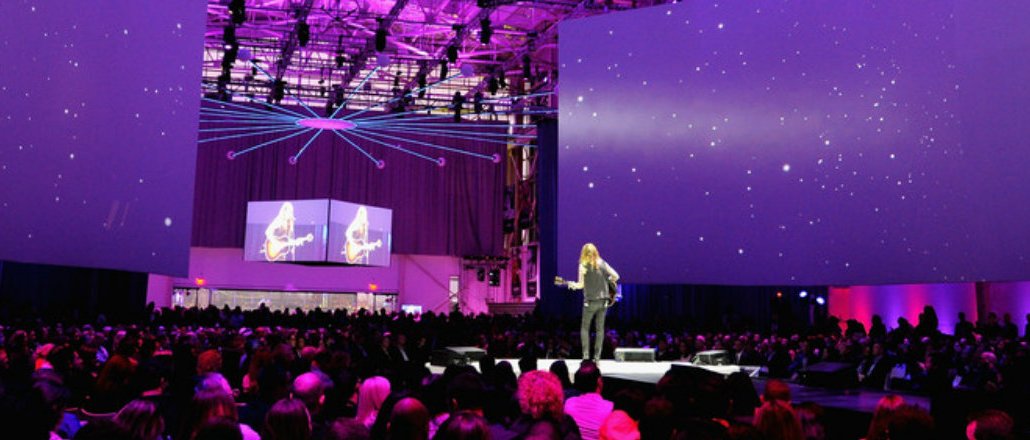

When CNN boss Jeff Zucker took the stage at Great Big Story’s NewFronts presentation to talk about the content his digital network has lined up for the coming year, he said something he’s never had to at a TV upfront: “These are not built-if-sold concepts. These are real projects that will grow our brand.”
Five years in, the Digital Content NewFronts are still trying to overcome an early hurdle: the “built-if-sold” model. Several presenters during the first week of this year’s NewFronts made sure to guarantee advertisers that they’ll actually make everything on their programming slate. Defy Media’s entire presentation, for instance, was about how it has 72 weekly shows in rotation. It’s constantly adding new ones, but it’s also succeeding in making programming that people return to on a regular basis — to the tune of 800 million views per month, the company said.
“While the NewFronts are about what’s never been done before, we think it’s important to pay respect to shows that work — the proven vehicles,” said Defy Media president Keith Richman to advertisers in the room. “You have our guarantee that we will make them.”
It’s a noticeable shift from years past when digital publishers would showcase programming only for it to never see the light of day. For instance, in 2014, Time Inc.’s slate included “I (Heart) My Closet,” which never made it past its pilot. The not-so-hidden truth to all this? Regardless of how enthusiastic the publisher was about a show, it needed an advertiser to fund it.
It’s been a problem for video publishers as they look to capture attention and ad dollars for their content, especially in the shadow of Big TV. Fox doesn’t have to reassure advertisers that “Empire” will air on its network during the TV season. Even if most programming showcased at the TV upfronts will be canceled by the network, there is confidence that the programming will actually air.
“It’s about trust,” said Amy Emmerich, chief content officer at Refinery29. “How can I stand up there and say we’re going to make something and then make nothing? Who would believe me ever again?”
Of the 29 formats Refinery29 previewed at its first-ever NewFront in 2015, 28 got made, Emmerich said. Similarly, PopSugar made nine of the 11 new series it previewed last year. Some of those programs, including “PopSugar Rush” and “Find Your Happy” are returning this year for additional seasons.
While PopSugar aims to have consistent programming that’s not reliant on advertisers, it recognizes the realities of the market. Digital is hot, but the money is still not there, which means some type of projects will need a brand partner, according to David Grant, president of PopSugar Studios. “When it’s a more ambitious project, we might need financing to do it on a sustained basis. It’s perfectly fine to say that,” he said.
Advertisers are, at best, diplomatic when it comes to the built-if-sold model. It depends on the needs of the clients, more than a few buyers said.
“I don’t think it’s an either-or situation,” said Sarah Baehr, evp and managing director of digital at Horizon Media. “There are clients who want to get more involved with the piece of content early on, and will jump at an interesting idea.”
And yet, many NewFronts presenters are eyeing the true prize: TV dollars that are beginning to flow into digital. Here, the big distributors — AOL, Hulu and YouTube — are at an advantage. Interpublic’s Magna Global signed a deal with YouTube to shift $250 million from its TV budget to the video platform in the coming year, according to The Wall Street Journal. Digital publishers that rely on some of these platforms for distribution have more pressure to prove that they can make great content that millions want to watch.
“Unless a program is a perfect match for an advertiser, the built-if-sold model is generally a pass for us,” according to one media buyer. “It’s not inspiring confidence when a publisher asks for money before the first frame is shot.”
More in Media

Why some publishers aren’t ready to monetize generative AI chatbots with ads yet
Monetization of generative AI chatbot experiences is slow going. Some publishing execs said they’re not ready to add advertising to these products until they scale or can build a subscription model first.

Media Briefing: Publishers who bet on events and franchises this year are reaping the rewards
Tentpole events and franchises are helping publishers lock in advertising revenue.

With Firefly Image 3, Adobe aims to integrate more AI tools for various apps
New tools let people make images in seconds, create image backgrounds, replacing parts of an image and use reference images to create with AI.





